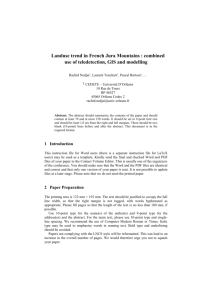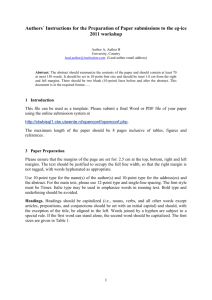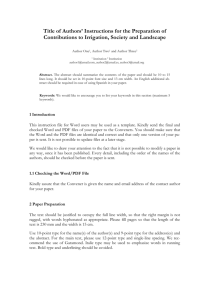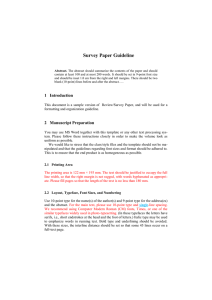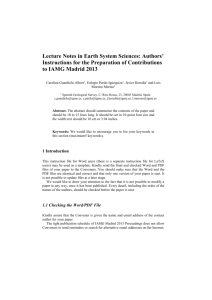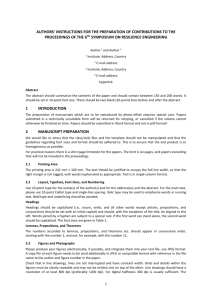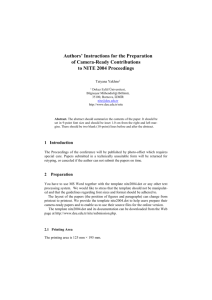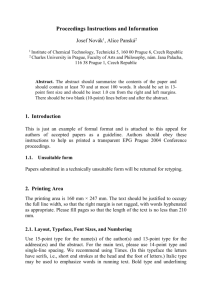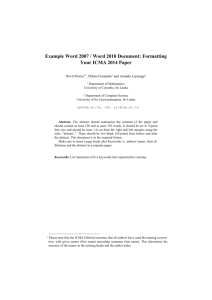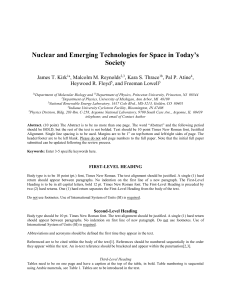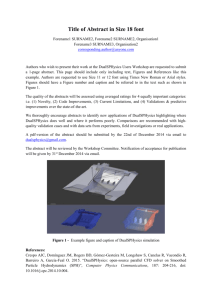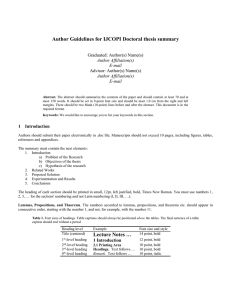Here - GDN 2015
advertisement
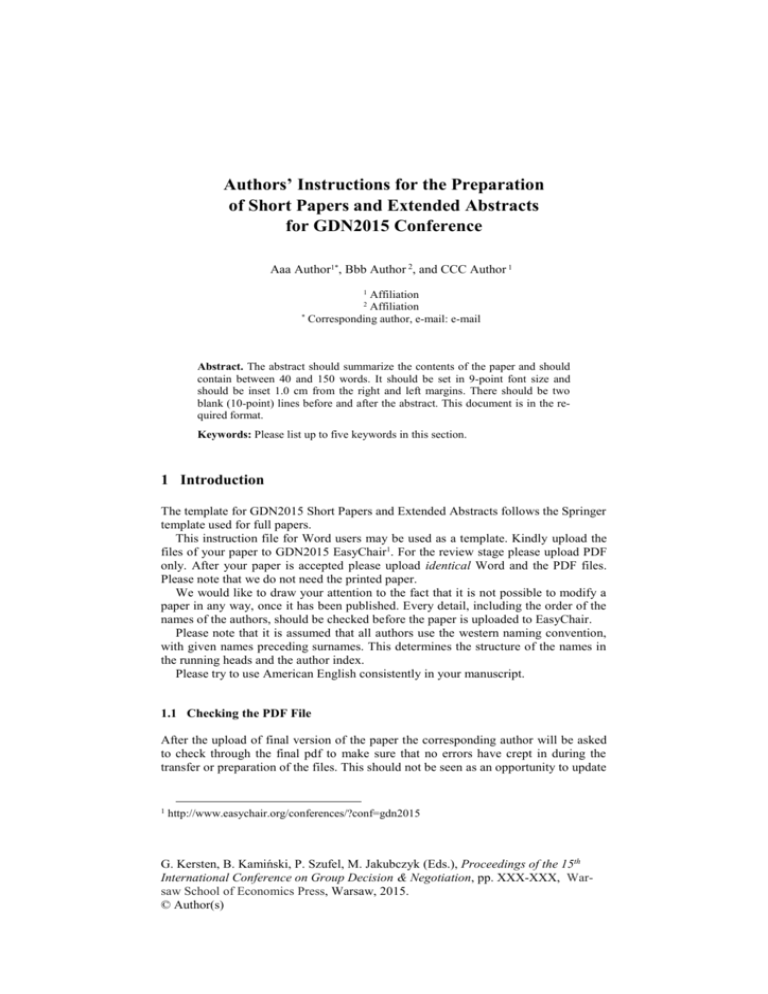
Authors’ Instructions for the Preparation
of Short Papers and Extended Abstracts
for GDN2015 Conference
Aaa Author1*, Bbb Author 2, and CCC Author 1
Affiliation
Affiliation
*
Corresponding author, e-mail: e-mail
1
2
Abstract. The abstract should summarize the contents of the paper and should
contain between 40 and 150 words. It should be set in 9-point font size and
should be inset 1.0 cm from the right and left margins. There should be two
blank (10-point) lines before and after the abstract. This document is in the required format.
Keywords: Please list up to five keywords in this section.
1 Introduction
The template for GDN2015 Short Papers and Extended Abstracts follows the Springer
template used for full papers.
This instruction file for Word users may be used as a template. Kindly upload the
files of your paper to GDN2015 EasyChair1. For the review stage please upload PDF
only. After your paper is accepted please upload identical Word and the PDF files.
Please note that we do not need the printed paper.
We would like to draw your attention to the fact that it is not possible to modify a
paper in any way, once it has been published. Every detail, including the order of the
names of the authors, should be checked before the paper is uploaded to EasyChair.
Please note that it is assumed that all authors use the western naming convention,
with given names preceding surnames. This determines the structure of the names in
the running heads and the author index.
Please try to use American English consistently in your manuscript.
1.1 Checking the PDF File
After the upload of final version of the paper the corresponding author will be asked
to check through the final pdf to make sure that no errors have crept in during the
transfer or preparation of the files. This should not be seen as an opportunity to update
1
http://www.easychair.org/conferences/?conf=gdn2015
G. Kersten, B. Kamiński, P. Szufel, M. Jakubczyk (Eds.), Proceedings of the 15th
International Conference on Group Decision & Negotiation, pp. XXX-XXX, Warsaw School of Economics Press, Warsaw, 2015.
© Author(s)
A.Author, B. Author and C. Author
or copyedit the papers, which is not possible due to time constraints. Only errors introduced during the preparation of the files will be corrected.
1.2 Copyright Forms
There is no copyright forms for this submission.
2 Paper Preparation
The printing area is 122 mm × 193 mm. The text should be justified to occupy the full
line width, so that the right margin is not ragged, with words hyphenated as appropriate. Please fill pages (e.g. by moving figures and tables about) so that the length of the
text is no less than 180 mm, if possible.
Use 10-point type for the name(s) of the author(s) and 9-point type for the address(es) and the abstract. For the main text, please use 10-point type and single-line
spacing. All text should be typeset in Times. Italic type may be used to emphasize
words in running text. Bold type and underlining should be avoided.
Papers not complying with the style presented in this document will be reformatted. This can lead to an increase in the overall number of pages. We would therefore
urge you not to squash your paper.
Lemmas, Propositions, and Theorems. The numbers accorded to lemmas,
propositions, and theorems, etc. should appear in consecutive order (with continuous,
not per-section, numbering), starting with Lemma 1, and not, for example, with
Lemma 11. Use separate counters for Lemmas, Theorems, etc. (e.g. Lemma 1,
Lemma 2, Theorem 1).
Headings. Headings should be capitalized (i.e., nouns, verbs, and all other words
except articles, prepositions, and conjunctions should be set with an initial capital)
and should, with the exception of the title, be aligned to the left. Words joined by a
hyphen are subject to a special rule. If the first word can stand alone, the second word
should be capitalized. The font sizes are given in Table 1.
Here are some examples of headings: "Criteria to Disprove Context-Freeness of
Collage Languages", "On Correcting the Intrusion of Tracing Non-deterministic Programs by Software", "A User-Friendly and Extendable Data Distribution System",
"Multi-flip Networks: Parallelizing GenSAT", "Self-determinations of Man".
Table 1. Font sizes of headings. Table captions should always be positioned above the tables.
Source: provide a source for data presented in the table.
Heading level
Title (centered)
Example
1st-level heading
2nd-level heading
1 Introduction
Title
2.1 Printing Area
Font size and style
14 point, bold
12 point, bold
10 point, bold
Authors’ Instructions
3rd-level heading
4th-level heading
Headings. Text follows …
Remark. Text follows …
10 point, bold
10 point, italic
2.1 Figures
Please check that the lines in line drawings are not interrupted and have a constant
width. Grids and details within the figures must be clearly legible and may not be
written one on top of the other. Line drawings should have a resolution of at least 800
dpi (preferably 1200 dpi). The lettering in figures should have a height of 2 mm (10point type). If possible try to use within figures font as similar to Times New Roman
as possible. Figures should be numbered and should have a caption which should
always be positioned under the figures, in contrast to the caption belonging to a table,
which should always appear above the table. Please center the captions between the
margins and set them in 9-point type (Fig. 1 shows an example). The distance between text and figure should be about 8 mm, the distance between figure and caption
about 6 mm.
A.Author, B. Author and C. Author
Fig. 1. One kernel at xs (dotted kernel) or two kernels at xi and xj (left and right) lead to the
same summed estimate at xs. This shows a figure consisting of different types of lines. Elements of the figure described in the caption should be set in italics, in parentheses, as shown in
this sample caption. Source: provide a source for data presented in the figure.
To ensure that the reproduction of your illustrations is of a reasonable quality, we
advise against the use of shading. The contrast should be as pronounced as possible.
If screenshots are necessary, please make sure that you are happy with the print
quality before you send the files.
2.2 Formulas
Displayed equations or formulas are centered and set on a separate line (with an extra
line or halfline space above and below). Displayed expressions should be numbered
for reference (and only expressions referred to should be numbered). The numbers
should be consecutive within the contribution (not per section), with numbers enclosed in parentheses and set on the right margin.
x+y=z.
(1)
Equations should be punctuated in the same way as ordinary text but with a small
space before the end punctuation mark.
2.3 Footnotes
The superscript numeral used to refer to a footnote appears in the text either directly
after the word to be discussed or – in relation to a phrase or a sentence – following the
punctuation mark (comma, semicolon, or period). Footnotes should appear at the
bottom of the normal text area, with a line of about 5cm set immediately above them2.
2.4 Program Code
Program listings or program commands in the text are normally set in typewriter font,
e.g., CMTT10 or Courier.
Example of a Computer Program
#include<stdio.h>
main()
{
2
The footnote numeral is set flush left and the text follows with the usual word spacing.
Authors’ Instructions
printf("Hello World");
}
2.5 Citations
For citations in the text please use square brackets and consecutive numbers: [1], [2],
[3], etc.
2.6 Page Numbering and Running Heads
There is no need to include page numbers. If your paper title is too long to serve as a
running head, it will be shortened. Your suggestion as to how to shorten it would be
most welcome.
Acknowledgments. The heading should be treated as a 3rd level heading and should
not be assigned a number.
3 The References Section
You should check your references thoroughly when you receive the final pdf of your
paper. The reference section must be complete. You may not omit references. Instructions as to where to find a fuller version of the references are not permissible.
We only accept references written using the latin alphabet. If the title of the book
you are referring to is in Russian or Chinese, then please write (in Russian) or (in
Chinese) at the end of the transcript or translation of the title.
The following section shows a sample reference list with entries for journal articles
[1], an LNCS chapter [2], a book [3], proceedings without editors [4] and [5], as well
as a URL [6]. If manuscript you cite is available ahead of print, use doi [7].
Please order your references in order as they are cited in the manuscript and abbreviate the journal name.
References
1. Smith, T.F., Waterman, M.S.: Identification of Common Molecular Subsequences. J. Mol.
Biol. 147, pp. 195–197 (1981)
2. May, P., Ehrlich, H.C., Steinke, T.: ZIB Structure Prediction Pipeline: Composing a Complex Biological Workflow through Web Services. In: Nagel, W.E., Walter, W.V., Lehner,
W. (eds.) Euro-Par 2006. LNCS, vol. 4128, pp. 1148–1158. Springer, Heidelberg (2006)
3. Foster, I., Kesselman, C.: The Grid: Blueprint for a New Computing Infrastructure. Morgan
Kaufmann, San Francisco (1999)
4. Czajkowski, K., Fitzgerald, S., Foster, I., Kesselman, C.: Grid Information Services for
Distributed Resource Sharing. In: 10th IEEE International Symposium on High Performance
Distributed Computing, pp. 181–184. IEEE Press, New York (2001)
A.Author, B. Author and C. Author
5. Foster, I., Kesselman, C., Nick, J., Tuecke, S.: The Physiology of the Grid: an Open Grid
Services Architecture for Distributed Systems Integration. Technical report, Global Grid Forum (2002)
6. National Center for Biotechnology Information, http://www.ncbi.nlm.nih.gov (access: 20th
Aug 2014)
7. Cao, Y.: Reducing interval-valued decision trees to conventional ones: Comments on decision trees with single and multiple interval-valued objectives, Decis. Anal., doi:
10.1287/deca.2014.0294 (2014)
